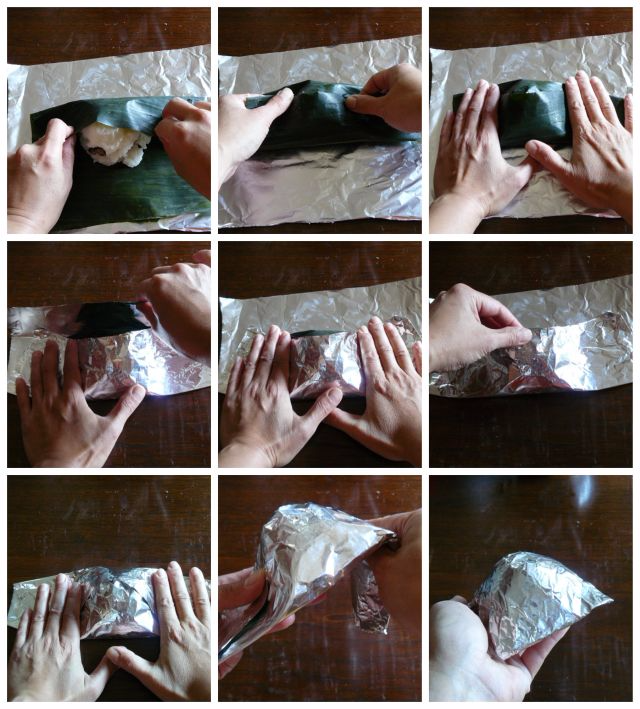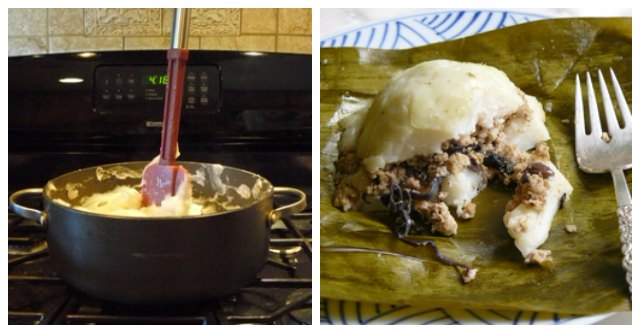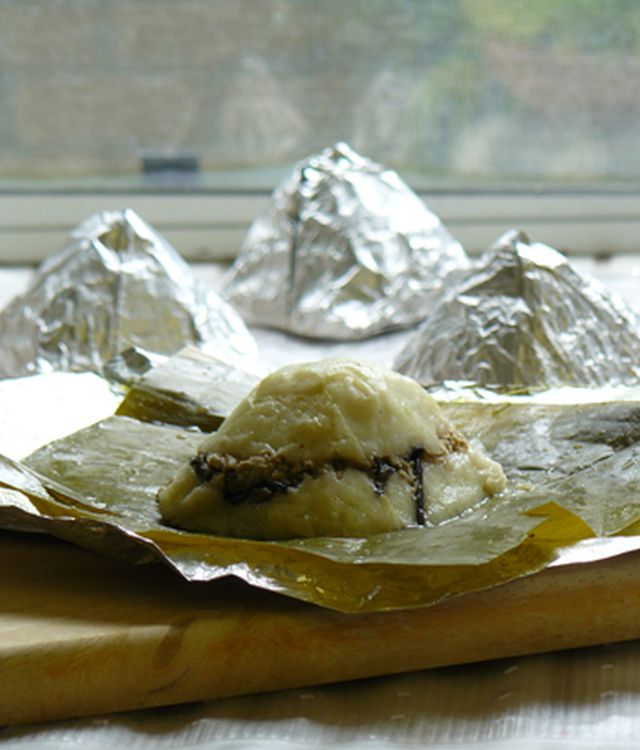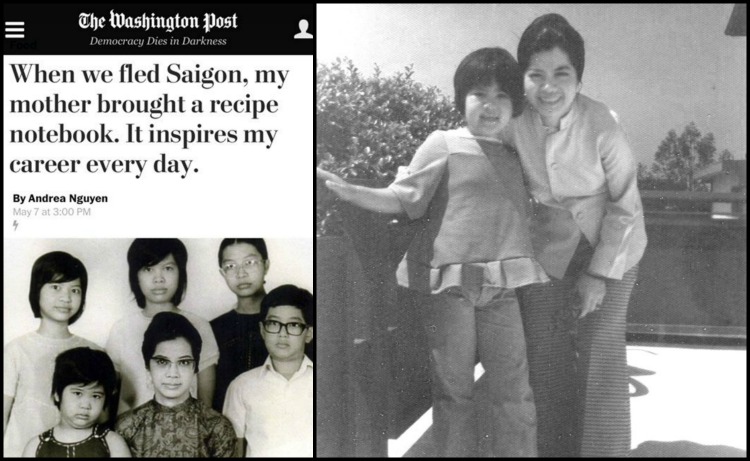My mother isn't a touchy-feely person but we are close. We're food pals and though I check in with her on a regular basis, this week, I'm thinking a lot about what it means to be a parent. I don't have kids or even a pet but I do appreciate what it takes to be a good parent. I've told my friends many times that parenting is one of the hardest careers, which is why I am not a parent.
Mom has said that she and my dad did their best to raise us. They had tough times and thankfully, things turned out well.
Maybe it's because of our shared interest in food and the fact that I don't have kids. My mom and I share cooking tips and recipes. In doing so, we have stories about how food reveals certain things about culture and humanity.
She's 83 and still curious and open to new ideas (I recently gave her a pressure cooker and she adores it for making pho from the book!) Much of our relationship has developed in the kitchen. She seeded my food writing career in many ways and I wrote about how she influenced me in a Mother's Day story published this week at the Washington Post.
The story got me thinking about the kinds of treats that Mom loves to prepare to spoil us to this day. One of them is a pyramid-shaped northern Vietnamese dumpling called banh gio (“baan zaw” or “baan yaw”). Each is the size of an average orange.
The dough is made of rice flour and the filling includes ground pork, mushroom, and shallot. It's simple food, like any good dumpling. The banana leaf casing imparts pale green color and a charming grassy, tea-like flavor. I can eat two banh gio for breakfast, sprinkled with a dash of fish sauce, though I know I should stop at one.
Like when I was growing up, Mom still makes dozens of them and keeps them frozen for when we come to visit. My husband adores them too so she often sends extras home with us. They’re fun and delicious for a weekend brunch or lunch or afternoon snack. To me, banh gio is a Viet dumpling comfort food.
What about the name, banh gio?
Banh is the generic Viet term for foods made with flours, legumes and starches. For example, banh mi means bread made from wheat flour (mi) as well as the sandwich. Banh gio got its name because the dumplings were traditionally made by professional gio makers who prepared Vietnamese charcuterie, particularly the everyday mortadellalike pork sausage called gio (it’s often featured in traditional banh mi).
Leftover scraps of pork would be chopped up, cooked and employed for these dumplings. There would be banana leaf around from making the charcuterie. As my mom recounts, you'd go to buy your Vietnamese sausages from the gio vendor and picked up some banh gio dumplings too! A win-win situation.
In America, you'd find these dumplings at a Vietnamese bakery or deli, typically where you'd pick up sandwiches and other snacks. They're not a restaurant thing because the dumplings require a certain level of skill to fill, shape and fold.
No problem. My mom shared her banh gio recipe and gave me a tutorial.
Mom's banh gio dumpling folding video
Below is a video from 2009. Mom hasn't changed her technique she says. I remember that when we got to her house, she had her mis en place all ready to go. My husband just had to hit 'record.'
In order to form the signature pyramid shape, banh gio is traditionally wrapped in many layers of banana leaf. Banana leaf is hard to manipulate (in Vietnam, certain kinds of banana trees yield the best leaves for cooking) and my mom wanted to make life easier on herself, so she used foil along with the leaf. She's a modern woman.
Many Viet-American cooks use foil and banana leaf to shape complicated dumplings like banh chung Tet sticky rice cakes, which are shaped like adobe bricks. Aluminum foil is not a common household thing in Vietnam, but in America, it's darn useful for holding things together because it can be bent and keep its shape!
With the combination of banana leaf and foil, banh gio becomes totally simple to master. Watch my mom:
In case the video isn’t enough, use these these photos to help you wrap banh gio:

This is an unusual dough because it starts out as a batter and then you cook it so it may be molded. Vietnamese dumpligns like this one and banh nam (thin tamale-like dumplings from the central region of Vietnam) are made with partially cooked dough. When you make the dough, know that blending cornstarch with store-bought Thai rice flour helps the dough to firm up.

My mom can make two or three dozen banh gio at a time. You don't have to. Make a small batch and enjoy them. This banh gio recipe is her gift to you!
More from my mom
Her kitchen wisdom and tasty recipes!
- Garlicky Panfried Pork Cutlets - Thit Cot-Let (one of my childhood favorites)
- Honey Baked Ham with Red Wine and Orange (because she loves Honey-Baked Ham)
- My Mom's Kitchen Quirks (including how she uses the dishwasher as a storage area)
- Yule Log Cake (Banh Buche de Noel) (because it's never too early to eat holiday treats)
Vietnamese Rice and Pork Pyramid Dumplings (Banh Gio)
Ingredients
- 3 tablespoons canola or other neutral oil
- ⅓ cup finely chopped shallot
- 8 ounces ground pork fatty kind preferred, coarsely chopped to loosen
- 2 large dried wood ear mushrooms reconstituted, trimmed, and finely chopped (¼ cup total)
- 1 ¼ teaspoons fine sea salt
- ¼ plus ⅛ teaspoon sugar
- Rounded ½ teaspoon recently ground black pepper
- 1 tablespoon fish sauce
- 1 ½ teaspoons cornstarch dissolved in 2 teaspoons water
- 8 ounces regular rice flour, any Thai brand, such as Erawan
- 2 ¼ ounces ½ cup cornstarch
- 4 ½ cups lightly salted chicken stock or low-sodium canned Swanson chicken broth
- 1 ½ cups water
- 8 squares thawed or fresh banana leaf each 9 inches wide, trimmed of any brown edges, washed, and wiped
- 8 pieces of aluminum foil each 9 by 10 inches
Instructions
- To make the filling: Heat 1 ½ tablespoons canola oil in a medium skillet over medium-high heat. Add the shallot and cook, stirring frequently, for about 3 minutes, until the edges have started to brown. Add the pork, stirring and poking it to break it into small pieces. When most of the pork has turned color, about 1 minute, add the mushroom. Give things a big stir, then sprinkle in the ¼ teaspoon salt, sugar, pepper, and fish sauce. Cook, for about 2 minutes, until the pork is just cooked through.
- Give the cornstarch a stir, add it to the mixture, and cook for about 30 seconds to lightly bind. Remove from the heat, taste, and add any flavor adjustments for a filling that’s well seasoned flavor. Shoot for a savory flavor that’s slightly more intense than what you’re used to as the dough is lightly seasoned. Transfer to a bowl and set aside to cool to room temperature. Makes about 1 ¼ cups. The filling can be made a day in advance and returned to room temperature before using.
- For the dough: Put the rice flour, cornstarch, and remaining 1 teaspoon salt into a large bowl. Make a well in the center and whisk in the chicken broth, water, and remaining 1 ½ tablespoons oil to form a smooth batter. Strain through a mesh strainer into a pot or large saucepan. Set aside for 10 minutes to bloom.
- Pour the batter through the strainer. Set the pot over high heat. Continuously stir with a wooden spoon at a moderate speed for about 8 minutes, or until a partially cooked, very thick dough forms. Midway through, the mixture will have thickened slightly and resemble white sauce. When you see lumps forming around the spoon, lower the heat slightly and keep stirring. The lumps will eventually disappear. When the dough resembles stiff mashed potatoes, turn off the heat and stir for another 30 seconds to ensure that the dough is smooth. When done, the spoon should be able to stand upright in dough. Remove from the heat and set aside, uncovered, to cool for 5 to 10 minutes.
- Use the wooden spoon or a rubber spatula to smooth out the dough in the pot, and then divide it into 8 even wedges, like a pie. This will help you eyeball the amount of dough for each dumpling.
- To form each dumpling: Set a piece of foil down on your work surface with one of the long sides closest to you. Center a piece of banana leaf, smoother side up, atop the foil. Brush a 3 ½-inch circle of oil in the center of the banana leaf. Then use an ice cream scoop or ¼-cup measuring cup to center half of a portion of dough atop the banana leaf. Dip two fingers in water and press then gently the dough into a ½-inch disk.
- Put 2 ½ tablespoons of filling in the center of the dough; try to keep the filling in a mound. Top with the remaining half portion of dough. It will look messy but don’t worry. Moistened a few fingers and gently press down to spread the dough out a bit and smooth things out. It should now look like a strange sandwich. Bring the edge of banana leaf that’s closest to you to the center, and then bring the edge at the top down to enclose the dumpling. The edges should overlap by ¼ to ½ inch. Pull them in tighter to ensure good coverage.
- Use your two hands to gently press down on the right and left edges to begin forming the pyramid shape. Bring the top and bottom edges of foil to the center and let them overlap, just like the banana leaf. Use your hands again to firmly press down on the sides to secure the square-shaped base. Finally, fold the open ends down and under the dumpling. Use scissors to trim any excessive foil poking out. Place the dumpling in a steamer tray (there’s no need to line the tray). Repeat with the remaining dumplings.
- Steam the dumplings over boiling water for 40 to 45 minutes, or until dumplings have puffed up slightly a skewer inserted comes out more or less clean; some dough sticking to the skewer is okay. Allow to cool for about 10 minutes before eating. Open up the foil and banana leaf and dive in with chopsticks or fork. The banana leaf is inedible.



















Hong says
Hi Andrea,
Could you please comment on the roles of rice flour and corn starch in banh gio recipes? I found a recipe on the web in which the ratio of rice flour and corn starch is 2:1, whereas yours is about 4:1. Then, there is another recipe where it calls for 2 cups of corn starch to 1 cup of rice flour!
Thank you.
Andrea Nguyen says
Cornstarch make for a firmer dough so using less of it, creates a more tender result. I like to taste the rice flour, too. Banh gio is traditionally made with soaked grains of rice that's ground then cooked. I've made it with professional Viet cooks and no way do they put a ton of cornstarch in the batter. Maybe the other recipes are looking for a sure thing by making the "bot" super firm so they can handle it? Cornstarch has little flavor. It controls texture.
What do you typically do? If I were you, I'd use my ratio and then increase the cornstarch, if you want. I assure you that what my mom uses produces exemplary results. She uses the same recipe to this day. Her banh gio are terrific.
cách làm bánh says
I remember the breakfast dumplings my mother used to make when I was young. The crispy mushroom meat is delicious, the shell is smooth.
Andrea Nguyen says
Yes, it's a fantastic breakfast dumpling!